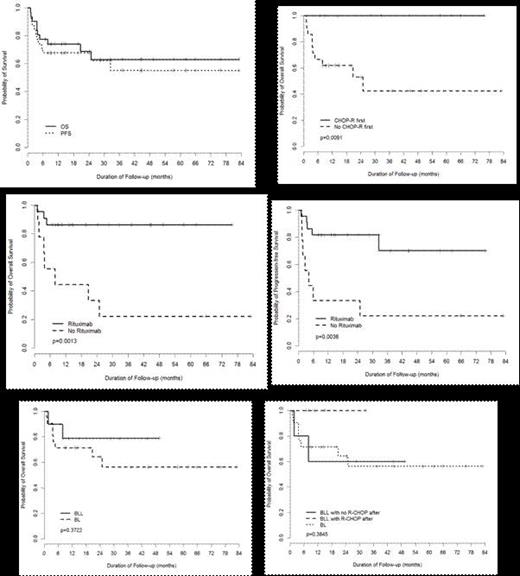Abstract
Dose-modified(dm) CODOX-M/IVAC is commonly used for Burkitt lymphoma (BL) and overlap aggressive B cell lymphomas (B-cell lymphoma, unclassifiable, with features intermediate between diffuse large B-cell lymphoma (DLBCL) and BL, previously Burkitt-like lymphoma-BLL), with high cure rates, but significant toxicity. The concurrent use of rituximab with CODOX-M/IVAC is relatively new in both BL and BLL. Methods: We undertook this retrospective study of BL and BLL patients treated at a large quaternary care cancer center with dmCODOX-M/IVAC +/-rituximab(R) in order to a) determine ‘real-world' toxicity and survival rates, b) examine the effects of BL versus intermediate histology diagnoses, and c) evaluate the effects of rituximab (R) use. Patients diagnosed between January 2006-December 2012 as having either Burkitt lymphoma or atypical Burkitt/Burkitt-like lymphoma (WHO Classification 2001), or B-cell lymphoma, unclassifiable, with features intermediate between diffuse large B-cell lymphoma and BL (WHO 2008) and who had received the dmCODOX-M/IVAC regimen,+/- R within 2 months of their diagnosis, were identified. In May 2008, we adopted the practice of adding R 375 mg/m2 to dmCODOX-M/IVAC in non-HIV patients due to emerging data from other centers. In 2012, our approach to BLL was altered, by adding 1-4 cycles of R-CHOP after the dmCODOX-M/IVAC protocol completion, to maximize anthracycline and rituximab delivery. The primary outcomes of interest were 2-year overall (OS) and progression-free survival (PFS). Univariate and multivariable Cox proportional hazard models of OS and PFS were constructed. Results: 31 patients with BL (n=21) or BLL (n=10) were included. The median age was 45, and 90% were high risk. 94% of patients displayed a MYC translocation (t(8;14)) by FISH cytogenetics. Additionally, 8 (26%) patients were BCL2+ by immunohistochemistry (IHC). Three were also positive for the t(14;18) (double-hit lymphomas), and one was unknown. Because of the diagnostic uncertainty (pending MYC status), 10 (32%) began treatment with chemotherapy other than dmCODOX-M/IVAC (mostly 1-2 cycles of CHOP+/-R). The median time from diagnosis to first chemotherapy was 13 days (1-58) and from first chemo to first HDMTX 10.5 days (0-57). In total, 22 (71%) patients received at least one infusion of rituximab at some point during first line treatment with a median of 3 infusions (range 1-7). Five of 10 BLL patients (50%) received a median of 2 additional R-CHOP cycles (range 1-4). In the patients who received R-CHOP first vs. those who did not, the median time from diagnosis to the first chemotherapy was 9 days (range: 1-21) compared with 17 days (range: 0-58) (p=0.29). Despite GCSF use, 24 patients (77%) experienced at least one episode of febrile neutropenia post dmCODOX-M and 12 patients (39%) post dmIVAC. The 2-year overall survival (OS) and progression-free survival (PFS) were 69% and 62%, respectively, with no differences between BL and BLL (Figure 1). When BLL was separated by whether R-CHOP was given, there were still no differences in OS between BL, BLL (“no R-CHOP after”) and BLL (“R-CHOP after”) (2-yr OS 64% vs. 60% vs. 100%, p=0.38; Figure 1 ). Patients who received rituximab had superior OS (2-yr OS 86% vs. 33%, p=0.0013; Figure 1 ) compared with those that did not. Starting with CHOP-R versus dmCODOX-M was associated with an OS benefit (2-yr OS 100% vs. 53%, p=0.009; Figure 1 ), despite no difference in OS whether time from diagnosis to first chemotherapy was ≥ or < 10 days (p=0.96) By multivariable analysis, rituximab use was significantly associated with improved OS (HR 0.15; 95%CI 0.04-0.56) and PFS (HR 0.05; 95%CI 0.01-0.32).
The addition of rituximab to dmCODOX-M/IVAC improves overall and progression free survival in both BL and BLL and is recommended. BLL is a challenging histology to treat with inferior outcomes to DLBCL when treated similarly. The use of an aggressive regimen such as R-dmCODOX-M/IVAC in BLL can yield promising results that are comparable to BL.
No relevant conflicts of interest to declare.
Author notes
Asterisk with author names denotes non-ASH members.


